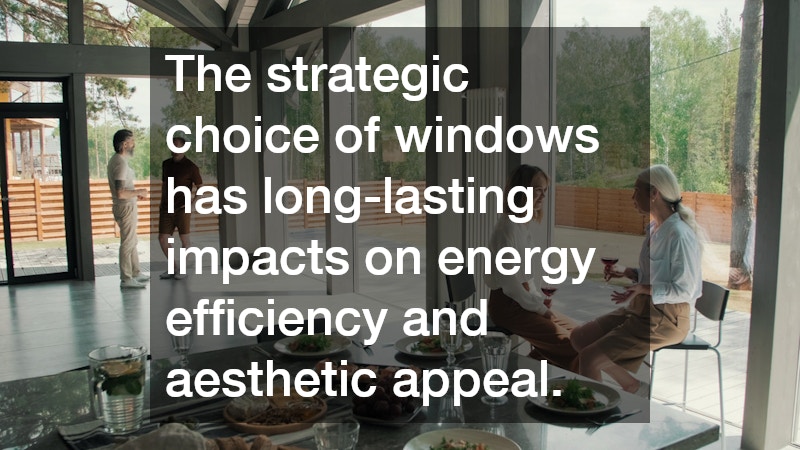Choosing the right windows is a crucial decision that impacts not only the aesthetic appeal of your home but also its overall energy efficiency. The type of windows you opt for can significantly influence your home’s comfort levels, reduce its environmental footprint, and increase its market value. Windows act as conduits between your interior space and the external environment, hence selecting energy-efficient solutions can considerably lower energy bills and create a more sustainable living space.
What types of windows are best for energy efficiency?
Understanding Energy Ratings and Certifications
Energy efficiency certifications like ENERGY STAR and NFRC ratings provide vital information about a window’s performance. ENERGY STAR-certified windows offer superior energy savings compared to non-certified counterparts, contributing significantly to reduced heating and cooling costs. Understanding and interpreting these ratings can empower consumers to make informed decisions, ultimately leading to more energy-efficient and environmentally friendly homes.
The U-factor and solar heat gain coefficient (SHGC) are essential components of these energy ratings. A low U-factor indicates better insulation properties, making it an essential consideration for colder climates. On the other hand, a lower SHGC is preferable for minimizing heat gain in warmer climates, thereby reducing air conditioning demands.
Material Considerations: Vinyl, Wood, and Aluminum
The choice of window material plays a significant role in determining energy efficiency. Vinyl windows are known for their excellent insulating properties and low maintenance requirements, making them a cost-effective option for many homeowners. In contrast, while wood offers a traditional and warm aesthetic, it requires more upkeep but provides natural insulation properties.
Aluminum windows, although durable and modern, have less insulative qualities compared to vinyl and wood. They are often used in contemporary designs, offering sleekness but sometimes necessitate thermal breaks to improve efficiency. Homeowners must weigh these pros and cons to select materials that align with their priorities and climate conditions.
Insulating Features: Double and Triple Glazing
Glazing plays a pivotal role in a window’s energy efficiency. Double and triple-pane windows enhance insulation, significantly reducing heat transfer compared to single-pane options. Such improvements can substantially lower energy use, translating into savings on heating and cooling bills.
The presence of inert gas fills, such as argon or krypton, between panes further boosts insulation. In conjunction with low-emissivity (Low-E) coatings, these features create a high-performance barrier that inhibits heat loss in winter and heat gain in summer. Homeowners benefit not only from energy savings but also from improved comfort and noise reduction.
However, the upfront costs for double and triple glazing can be higher than single-pane windows. It’s crucial to consider the long-term benefits, as energy savings can offset initial expenses over time. For those residing in extreme climates, the investment in advanced glazing options often proves worthwhile in enhancing home efficiency.
How can I choose windows that complement my home’s style?
Matching Window Styles with Architectural Designs
Windows contribute to a home’s character, and choosing the right style can accentuate its architectural design. Casement windows, known for their versatility and clean lines, seamlessly integrate into modern architectural styles. On the other hand, sash windows are an excellent choice for traditional homes, adding classic charm and functionality.
Bay windows offer an elegant touch, often becoming focal points in a room and enhancing both curb appeal and interior space. They are well-suited for Victorian and Colonial-style homes, where their grandeur and panoramic views create a dramatic effect. While selecting window styles, it is vital to consider both functionality and design harmony.
Color and Finish Options to Enhance Aesthetics
Color and finish are integral components of window design, influencing both exterior and interior styling. Windows that complement the color palette of the home’s facade blend seamlessly, creating a harmonious look. Popular choices, such as neutral tones, offer timeless appeal while bolder colors reflect personal style.
Modern technologies allow for a vast array of finishes, from sleek metallic to classic woodgrain looks. These options enable homeowners to achieve a desired aesthetic without compromising on material properties. It’s also important to consider interior finishes, ensuring they align with the home’s decor theme and reflect the desired ambiance.
Balancing Modern Trends with Timeless Appeal
Integrating modern trends into window design can revitalize a home’s appearance, but balancing these with timeless elements ensures long-term satisfaction. Trending features like large, unobstructed glass panels cater to contemporary preferences for abundant natural light. However, it is crucial to ensure these trends do not detract from the building’s lasting architectural charm.
Timeless design focuses on enduring styles and functionality, ensuring that the home remains appealing through changing trends. Careful selection of window styles that blend current trends with classic aesthetics can safeguard the property’s market value. It encourages a thoughtful approach that considers both present and future preferences.
Rebates and Incentives for Energy-Efficient Upgrades
Government programs often offer rebates and incentives for homeowners investing in energy-efficient upgrades, including windows. These incentives aim to offset costs, encouraging the adoption of environmentally responsible choices. Tax credits or direct rebates reduce the financial impact of making sustainable home improvements.
A wide range of programs are available at both federal and state levels, catering to different homeowner needs. Eligibility criteria vary, but they typically require using certified products to qualify for these benefits. Exploring these options enables homeowners to maximize savings while contributing to a more energy-efficient future.
Taking advantage of these programs supports broader goals of reducing energy consumption and promoting sustainable living. It reflects a commitment toward environmental stewardship and responsible homeownership. By leveraging these opportunities, homeowners achieve financial benefits while investing in the planet’s well-being.
The strategic choice of windows has long-lasting impacts on energy efficiency and aesthetic appeal. By selecting the right materials and styles, homeowners can achieve greater comfort, reduced energy bills, and enhanced property value. This article has explored the vital aspects of window selection, providing insights and guidance for making informed decisions.




